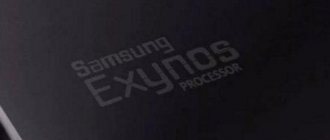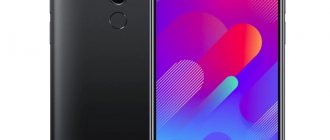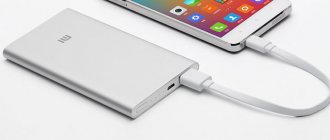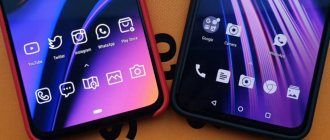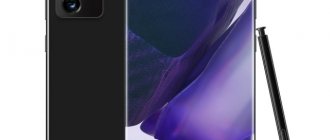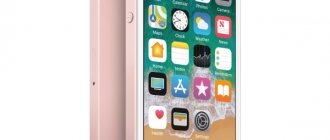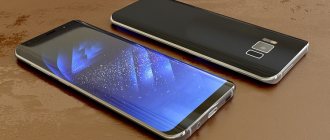Modern smartphones use two types of screens - OLED based on organic light-emitting diodes and liquid crystal LCD. Technologies have evolved significantly since their inception, and the quality of the picture has increased significantly, while users never tire of arguing about which matrix is better. Since the display is an important element of the device, doubts when choosing are completely justified.
When choosing which type of screen to prefer, AMOLED or IPS, you need to analyze the pros and cons of each of the technologies used. And here the user will have to decide on his own requirements for image presentation in order to ensure comfortable use of the device. The issue of price no longer matters, since in this regard the technologies are almost equal (previously, devices with IPS were significantly cheaper). Let's look at what the types of matrices common in smartphones are, and also look at their advantages and disadvantages.
What types of screens are there?
The structure of the main types of displays
Displays of modern electronics are constantly evolving. Cathode ray tubes became extinct and were replaced by liquid crystals and LEDs.
Today, at least 4 large classes of screens with their own manufacturing technology and image display features coexist simultaneously on the market.
TN (Twisted Nematic). The most affordable display that uses liquid crystals to create images, the image on which becomes visible thanks to backlighting from incandescent, fluorescent and other lamps. This class is obsolete, although in a number of use cases it has no analogues.
STN (Super Twisted Nematic) , as well as Double STN and DSTN (Dual-ScanTwisted Nematic). Continuation of LCD screens with improved parameters. They are sold under the name regular TN.
IPS (In-Plane Switching). A type of LCD that uses a more uniform and bright LED backlight.
VA (Vertical Alignment). Philips proprietary matrix, which combines the advantages of IPS and TN matrices. The characteristics are somewhere in between, as are the advantages and disadvantages. Not used in compact electronics.
AMOLED (Active Matrix Organic Light-Emitting Diode). Instead of a two-layer “liquid crystal + backlight” matrix, the technology uses a single layer of organic LEDs: they provide both color and light.
IPS Features You Need to Know About
Basic design of an IPS screen
IPS matrices have become so widespread due to the fact that they are really easy to produce. Among their advantages:
Availability. Mass production is doing its job, making it possible to use the TN matrix production factories of the past to create IPS.
Color rendition. Liquid crystals can display many colors, and LED perfectly complements the capabilities by accurately illuminating the current position of the pixels. In addition, the experience of engineers has made it possible to turn IPS matrices into the most accurate displays. True, so far the matter does not concern black color.
Energy consumption. Liquid crystals that form the image on an IPS screen consume almost no current. The main energy consumer is backlight diodes.
Durability. Liquid crystals are not subject to aging and wear. Backlight LEDs also have a huge resource.
Uneven illumination is clearly visible
However, IPS has many theoretical and actual disadvantages:
Black color. A TN matrix cannot have a pure black color: under the color emitter layer there is still a backlight that forms an image trail.
Low contrast. The low depth of black does not allow the shades of gray to be accurately separated; they are mixed. In addition, the backlight has a narrow luminosity range, which results in a low difference between the brightest and darkest pixels.
Great response time. In this case, the problem is entirely in the backlight: its LEDs simply do not have time to respond quickly.
Games
Input delay
While older OLED models suffered from very high input lag, the newer versions have managed to reduce this significantly by introducing a "Game Mode" that bypasses certain image processing.
Input lag on LG's 2022 OLED TVs is only ~13ms at 60Hz and ~8ms at 120Hz, which is less than some gaming monitors!
Some high-end LED TVs have input lag exceeding 40ms, which is not preferable for gaming.
You should get a TV with an input lag of less than 32ms - ideally less than 16ms at 60Hz - if you want smooth and responsive gameplay.
Response time
OLED displays also have incredibly fast response times of less than 1ms, making them ideal for fast-paced gaming.
On a TV with an IPS panel, the response speed is slower (~15ms), resulting in more noticeable ghosting or tracking of fast-moving objects.
AMOLED Features You Need to Know About
Basic design of an AMOLED screen
In turn, [A]MOLED has its own set of diseases: independent LEDs are both harmful and beneficial. So, among the advantages:
Separate pixel glow. One pixel is one LED that stays off when displaying black, providing nearly infinite contrast.
High speed. Separate pixel control helps achieve higher frame rates, which are achieved through fairly complex control circuits.
Low power consumption. Dark areas for AMOLED require less power consumption, while black areas consume nothing. Conversely, white color is extremely ruinous for them.
Uneven LED size leads to artifacts
However, existing technologies leave a number of “childhood diseases” that cannot yet be eliminated.
PWM All LEDs glow in pulses. This becomes noticeable at low display brightness. In IPS this is solved by rows of synchronous backlighting, but in AMOLED you have to look for a balance: either a bright glow with a blue tint (it is better visible to the human eye), or a low frequency of “blinking” diodes (high strain on the eyes).
White balance. Blue LEDs burn out faster due to technological features, so AMOLED screens suffer from incorrect color display (sometimes as a preventative measure).
Memory effect. A static picture causes OLEDs to lose brightness, which leads to artifacts over time.
PenTile. An attempt to solve the problem of blue LEDs led to the use of a different number of subpixels. And this is visible at low brightness.
Image quality
Permission
In terms of screen resolution, both OLED and LED TVs (IPS and VA) offer 4K Ultra HD resolution (some even 8K), which is a must-have specification if you're shopping for a new TV now.
Ideally, you'll also want your new TV to have HDR support.
HDR (High Dynamic Range)
HDR, whether in the form of HDR 10 or Dolby Vision, further enhances the color gamut, contrast, and brightness of compatible content to enhance the viewing experience.
However, not all content supports HDR, so before you buy an HDR TV, make sure your favorite TV shows and movies support it.
Even if they don't, it's a great way to future-proof your TV.
Learn more about HDR and how it works here.
Viewing Angles
While IPS panel displays have wide viewing angles of 178 degrees, they don't come close to those of OLED panels, which deliver perfect picture quality no matter the angle at which you view the screen.
Brightness Contrast
As mentioned, OLED TVs cannot produce as bright a picture as some high-end LED-backlit LCD TVs. But we don't mean to say that OLED displays aren't bright enough—far from it.
If you buy an OLED TV, one thing is for sure: you will be blown away by the picture quality due to its superb contrast ratio that makes blacks truly black and whites amazingly bright.
Local dimming
Some LCD TVs address the lack of contrast by adding local dimming, which darkens areas of the screen that should be darker without affecting the surrounding bright pixels.
There are two types of localized dimming: full array and edge dimming.
Full-length local dimming (FALD) TVs provide the best LCD picture quality, but can also cause a side effect known as ghosting or blooming, which can cause the bright part of the picture surrounded by dark pixels to have a ring of light. Around him.
It depends on how well the FALD is implemented, how many zones it has, and the quality of the panel.
Alternatively, edge-lit TVs are usually cheaper but cannot produce black tones as deep. You may experience flickering or blurred images, although you can always change the sensitivity setting to reduce it.
In any case, be sure to research how well local dimming works on the LCD TV you're looking to buy, as it can do wonders for picture quality, especially for HDR content.
How and what will we test?
For the purity of the experiment and the most correct comparison of the 2 types of screens, we will test smartphones. They are the ones who use the highest quality matrices: small displays are easier to make than huge TV panels.
The test subjects will be 2 Xiaomi smartphones: in the left corner of the ring is a Mi 8 with an AMOLED matrix, in the right is a simplified Mi 8 Lite with an IPS screen.
The belonging of devices to one manufacturer and generation gives a rough idea of the development of technologies in a cross-section.
The more affordable Mi 8 Lite is cheaper, not least thanks to the screen, but to maintain its position, the sub-flagship must be equipped with the highest quality matrix. No worse than the flagship.
Content:
- 1 Features of the technology 1.1 What are the features of Super Amoled
- 6.1 What technology has given to mobile devices
Super Amoled technology is a new method of producing TV matrices, which was developed by Samsung. The term has become widespread due to advertising campaigns of the brand, which is actively promoting its equipment with this creation technology. Other manufacturers often prefer LCD IPS matrices. Let's take a closer look at what an Amoled display is, and whether it is really better than classic options from other brands.
Brightness and operating features
IPS screen of Mi 8 Lite (left), AMOLED screen of Mi 8 (right)
The smartphone screens are completely identical in size and resolution, differing only in the size of the “cutout” for the front camera. This allows you to view the parameters in detail.
And we will do this not in the laboratory, but in combat conditions of complex lighting, it’s more visual and interesting. Especially when it comes to what matters most: brightness, backlight uniformity and image clarity.
Mi 8 AMOLED screen
As you can see in the photo above, even the OGS screen (without an air gap) of the Mi 8 Lite has more glare. The reason is 3 layers of the screen: protective glass, a layer of liquid crystals, backlight.
A more uniform backlight allows for greater visible color density, which looks “bolder” on the Mi 8 with AMOLED. The thing is that brightness, contrast and dynamic range are indeed higher even at similar levels.
IPS screen Mi 8 Lite
If you pay attention, the fonts on the AMOLED screen are clearer and more sharply drawn. Moreover, in cases with complex colors, dull shades.
However, background areas on the LCD display are better developed, soft transitions are brighter and more distinguishable.
Flaws
OLED image retention/burnout
The main problem with OLED displays is image burn-in. If you leave your TV with a static image for a long time, there is a chance that the image will burn out and become permanently visible in the background.
However, newer OLED models have built-in screen savers to prevent this, but you still need to be careful.
Another problem is image retention, which is similar to image burn-in, but it is not permanent as it disappears after a few minutes or after updating the pixels using a special TV function.
However, if you play video games on an OLED TV for a long time, fixed HUD elements such as maps, health bars, menus, etc. may remain visible for some time even after the image changes. Of course, this only happens in certain and rare scenarios and is easily resolved.
IPS Glow and Backlight Bleeding
IPS panels suffer from "IPS glow" and backlight leakage, which is characterized by light leakage at the corners and edges of the screen and is especially noticeable in dark rooms with dark scenes on the screen.
This can significantly degrade the experience of watching a movie in a dark room, since blacks aren't just greyish; they glow slightly at the edges of the screen.
Artifacts that are not visible
Mi 8 AMOLED screen: Pentile
Macro shots, even at maximum brightness, reveal the shortcomings of each type of display.
The OLED matrix used by Xiaomi shows off its structure. The eye usually doesn't notice uneven pixel brightness, but the white background and the camera show the defect.
The same Pentile, which is typical for all similar screens, may or may not be visible. But one way or another, this structure is used in all mass displays.
Mi 8 Lite IPS screen: visible pixel grid
The liquid crystal matrix shows its structure in any color, at any brightness. But the pixel grid does not strain the eyes, unlike uneven brightness.
In addition, increasing the backlight frequency beyond 60 Hz practically eliminates the main drawback of the IPS panel. With AMOLED this trick is more difficult, but still irritates the eyes.
What is the difference between the displays
So, how do competing technologies differ? Which display to choose: IPS, AMOLED or Super AMOLED.
To summarize, we can say that the main difference lies in the following parameters:
- color rendition. It will be more natural in IPS;
- energy consumption. Below in AMOLED. But in the case of too light images, this advantage is lost and is practically comparable to IPS;
- life time. Longer in IPS, due to the absence of LEDs;
- screen thickness. Less for AMOLED;
- price. Below in IPS;
- viewing angle. Equally good in both matrices.
These differences may be completely invisible or insignificant to the user
Color: where is the right one?
Mi 8 Lite IPS screen (left), Mi 8 AMOLED screen (right), cool color scheme
With the colors of different types of screens, everything is not as smooth as it seems. It is widely believed that AMOLED has a poisonous gamma, IPS is better adjustable and offers the most accurate gamma.
In practice, everything is confirmed by the human eye and turns out to be exactly the opposite when studied through optical instruments.
Mi 8 Lite IPS screen (left), Mi 8 AMOLED screen (right), standard color scheme
It's all about the insidiousness of the protective glass coatings: the developers managed to “soften” the white on the Mi 8 AMOLED panel using an oleophobic coating.
The same anti-greasy coating on the glass of the Mi 8 Lite gives the opposite effect, seriously distorting the gamma into a cold spectrum.
This behavior occurs with any color gamut settings. What's the matter?
Mi 8 Lite IPS screen (left), Mi 8 AMOLED screen (right), warm color scheme
The screen of the Mi 8 Lite has too much glare due to the split structure, while the gamma of the Mi 8 does not need correction. The absence of layers allows the display to show what the developers intended, regardless of external conditions.
Macro photographs only confirm what has been said. Adjusted for overall brightness, the Mi 8's brightness levels are always higher.
Answers to popular questions
What is SuperAMOLED?
A type of matrix that is used primarily in expensive devices. The peculiarity of its production is the absence of an air gap between the glass with the sensor and the display. This solution made it possible to get rid of image delamination and strong glare in the sun.
How long does it take for AMOLED to burn out?
The burnout period depends on various factors, the main one of which is the time the device is used in increased brightness mode and when all pixels are used.
The more often the owner uses a device with a white or color screen, the faster it will burn out. Using a personal example, after a year and a half of using Huawei P20 Pro, the screen faded by 1-1.5 tones, the screen turned into a slight yellowish tint. The device is still comfortable to use. To summarize the above, we can say the following: none of the methods for making a matrix is perfect; when choosing this or that smartphone, we always sacrifice something. Nowadays, fewer and fewer devices are installing IPS and more and more are switching to OLED, since the image quality on AMOLED is generally better than on LCD.
Let's look at it from an angle
IPS screen of Mi 8 Lite: transparent colors, correct white
A more careful study at close range changes the position of the liquid crystal matrices: now AMOLED glares, IPS does not.
Only then does it become clear that there is no real difference between the white balance of screens, it all depends on external distortions and perception.
Selecting a different lens and shooting conditions will turn the situation in a different direction. Therefore, it is the structure and refresh rate that will determine the quality of color rendering.
AMOLED screen of Mi 8: rich colors, correct blacks
In this case, AMOLED will have a hard time, since increasing the shooting speed will leave the white color white for IPS, and iridescent for the organic LED matrix.
Returning to the title, it should be noted: there are no visible problems when changing the viewing angle for both types of matrices. Not surprisingly, the refresh rate and pixel density are too high.
At low resolutions, IPS will demonstrate black problems at an angle.



